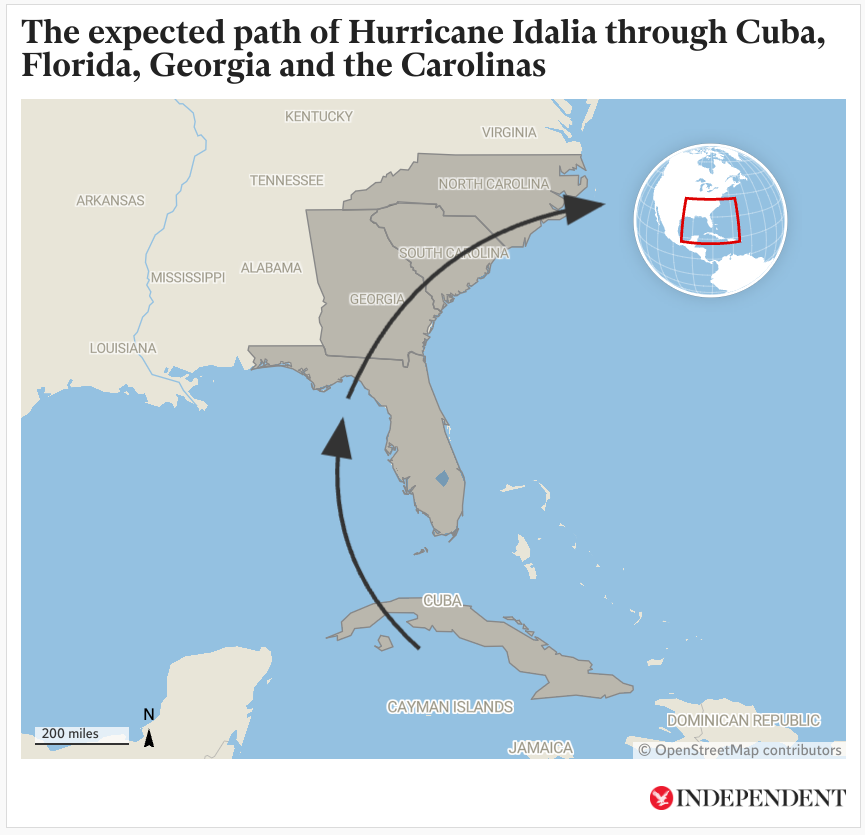Where is Hurricane Idalia now? Tropical storm system mapped
Storm is zeroing in on Carolinas after leaving trail of devastation in northern Florida
Hurricane Idalia was downgraded back to tropical storm status on Wednesday after making landfall in Keaton Beach in northeastern Florida’s Big Bend and crossing into Georgia, losing some of its power but still leaving behind a trail of flooding and destruction in its wake.
The storm is now headed for the Carolinas before dropping out into the Atlantic Ocean over the weekend but has so far proved far less destructive than initially feared, providing only glancing blows to Tampa Bay.
Even so, the 125mph winds with which it arrived from the Gulf of Mexico did plenty of damage, as captured by drones flying overhead, and left as many as half a million Floridians without power after ripping down electricity poles and cables across the north of the state.
The Big Bend area, where the Florida Panhandle curves into the peninsula, saw streets turned into rivers that submerged cars and homes, while the howling winds tore off roofs, snapped tall trees, sent sheet metal flying and shredded homes.
Rescue and repair efforts are continuing in the areas the storm passed through on Wednesday but there has been no immediate word on the death toll from its ferocious winds and inundating waters, although authorities have counted at least one fatality.
North Carolina governor Roy Cooper, who declared a statewide emergency earlier this week, has warned residents in coastal and eastern inland counties to prepare for heavy rainfall and localised flooding, urging them to stay off roads covered by floodwater.
In South Carolina, the storm coupled with king tides to send seawater flowing over sand dunes and spilling onto beachfront streets.
In Charleston, a surge from Idalia topped the seawall that protects the downtown, sending ankle-deep ocean water into the streets and neighbourhoods where horse-drawn carriages pass million-dollar homes and the famous open-air market.
Preliminary data showed the Wednesday evening high tide reached just over 9.2 feet, more than three feet above normal and the fifth-highest reading in Charleston Harbour since records were first kept in 1899.
Bands from Idalia also brought short-lived tornadoes. One flipped a car in suburban Goose Creek, South Carolina, causing minor injuries, authorities said.
Earlier this week, western Cuba was hit by torrential rainfall and flooding from Idalia, bringing further devastation to the tobacco-producing province of Pinar del Rio, which was hammered by Hurricane Ian last September.
Its impact led Floridians to prepare for the worst, with many loading up on sandbags and others living in low-lying areas along the Gulf Coast packing up their cars, readying generators and evacuating their homes to be out of harm’s way.

Florida governor and presidential candidate Ron DeSantis had declared a state of emergency in 46 counties, a broad swathe that stretches across the northern half of the state from the Gulf Coast to the Atlantic. In the event, Mr DeSantis’s own mansion was struck by a fallen tree.
State officials, 5,500 National Guardsman and rescue crews went into search-and-recovery mode once Idalia had crossed state lines into Georgia, inspecting bridges, clearing toppled trees and looking for anyone in distress. More than 30,000 utility workers gathered to repair the downed power lines and poles.
President Joe Biden called the governors of Florida, Georgia, North Carolina and South Carolina on Wednesday and told them their states had his administration’s full support, the White House said.
Idalia is just the latest in a summer of natural disasters to hit North America, from deadly wildfires in Hawaii and Canada to the first tropical storm to hit California in 84 years – marking the latest illustrations of the climate crisis in action.
Additional reporting by agencies.
Join our commenting forum
Join thought-provoking conversations, follow other Independent readers and see their replies
Comments


Bookmark popover
Removed from bookmarks